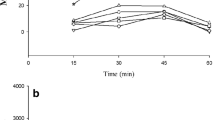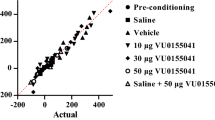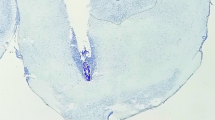Abstract
Morphine addiction is known as a serious social problem. Medial prefrontal cortex (mPFC) and ventral tegmental area (VTA) are two important sites of the brain that contribute to this type of addiction, and a complicated relation exists in between. In addition, neurotransmitters like glutamate and γ--Amino Butyric Acid (GABA) play an important role in the formation of these relations. Thus, the present study was undertaken to investigate these relations by evaluating the level of associated changes in the indicated neurotransmitters in the VTA, using HPLC method. This was performed after electrical stimulation and inducing lesion of mPFC and through microinjections of N-Methyl-D-Aspartate (NMDA) and α-amino-3-hydroxy-5-methyl-4-isoxazolepropionic acid (AMPA) receptor antagonists, respectively AP5 and CNQX, into the VTA of addicted rats. Our results showed that intra-peritoneal (i.p.) administration of morphine in 9 days in the morphine group, and also electrical stimulation (100 μA) of mPFC, receiving (i.p.) morphine, caused an increase in the glutamate release in the VTA, compared to the control group, but the increase of glutamate levels in the VTA in the morphine-stimulation group was not significant, compared to the morphine group. Moreover, GABA release into this area was decreasing in morphine and morphine- stimulation groups, compared to the control group. Our findings also showed that electrical lesion (0.4 mA) of mPFC, and also microinjection of glutamate antagonists into the VTA, receiving (i.p.) morphine in rats, caused a decrease of glutamate in the VTA. Therefore, it could be concluded that the relation between mPFC and VTA is highly effective in the formation of reward system.





Similar content being viewed by others
Abbreviations
- mPFC:
-
Medial prefrontal cortex
- VTA:
-
ventral tegmental area
- NMDA:
-
N-Methyl-D-Aspartate
- AMPA:
-
α-amino-3-hydroxy-5-methyl-4-isoxazolepropionic acid
- GABA:
-
γ--Amino Butyric Acid
- BNST:
-
stria terminalis
- i.p:
-
Intraperitoneally
- PL:
-
prelimbic
- AP:
-
anterioposterior
- ML:
-
mediolateral
- DV:
-
dorsoventral
References
Alaei H, Huotari M, Piepponen P, Ahtee L, Hanninen O, Mannisto P (2003) Morphine rele ases glutamate through ampa receptors in the ventral tegmental area: a microdialysis study in conscious rats. Med J Islamic Repub Iran (MJIRI) 17:225–231
Bonci A, Malenka RC (1999) Properties and plasticity of excitatory synapses on dopaminergic and GABAergic cells in the ventral tegmental area. J Neurosci 19:3723–3730
Carr DB, Sesack SR (2000) Projections from the rat prefrontal cortex to the ventral tegmental area: target specificity in the synaptic associations with mesoaccumbens and mesocortical neurons. J Neurosci 20:3864–3873
David V, Durkin TP, Cazala P (1998) Rewarding effects elicited by the microinjection of either AMPA or NMDA glutamatergic antagonists into the ventral tegmental area revealed by an intracranial self-administration paradigm in mice. Eur J Neurosci 10:1394–1402
Fanous S, Lacagnina MJ, Nikulina EM, Hammer RP Jr (2011) Sensitized activation of Fos and brain-derived neurotrophic factor in the medial prefrontal cortex and ventral tegmental area accompanies behavioral sensitization to amphetamine. Neuropharmacology 61:558–564
Ghalandari-Shamami M, Hassanpour-Ezatti M, Haghparast A (2012) Glutamate receptors in nucleus accumbens can modulate canabinoid-induced antinociception in rat’s basolateral amygdala. Basic Clin Neurosci 3:11–18
Ghavipanjeh GR, Pourshanazari AA, Alaei H, Karimi S, Nejad MA (2015) Effects of temporary inactivation and electrical stimulation of the dorsal raphe nucleus on morphine-induced conditioned place preference. Malays J Med Sci: MJMS 22:33
Harris G, Wimmer M, Byrne R, Aston-Jones G (2004) Glutamate-associated plasticity in the ventral tegmental area is necessary for conditioning environmental stimuli with morphine. Neuroscience 129:841–847
Harte M, O'Connor W (2005) Evidence for a selective prefrontal cortical GABA B receptor-mediated inhibition of glutamate release in the ventral tegmental area: a dual probe microdialysis study in the awake rat. Neuroscience 130:215–222
Jalabert M, Bourdy R, Courtin J, Veinante P, Manzoni OJ, Barrot M, Georges F (2011) Neuronal circuits underlying acute morphine action on dopamine neurons. Proc Natl Acad Sci 108:16446–16450
Javadi S, Alaei H, Hosseini E, Edalatmanesh MA (2017) The blockade of glutamate N-methyl-D-aspartate receptors into the prelimbic of prefrontal cortex decreases morphine-induced conditioned place preference in rat. Indones Biomed J 9:165–172
Kalivas PW, LaLumiere RT, Knackstedt L, Shen H (2009) Glutamate transmission in addiction. Neuropharmacology 56:169–173
Marghmaleki VS, Alaei HA, Malekabadi HA, Pilehvarian A (2013) Effect of physical activity on symptoms of morphine addiction in rats, after and before of lesion of the mpfc area. Iran J Basic Med Sci 16:1091–1909
Nowak K, Meyza K, Nikolaev E, Hunt MJ, Kasicki S (2012) Local blockade of NMDA receptors in the rat prefrontal cortex increases c-Fos expression in multiple subcortical regions. Acta Neurobiol Exp (Wars) 72:207–218
Paxinos G, Watson C (1998) A stereotaxic atlas of the rat brain. Academic, New York
Piepponen TP, Skujins A (2001) Rapid and sensitive step gradient assays of glutamate, glycine, taurine and γ-aminobutyric acid by high-performance liquid chromatography–fluorescence detection with o-phthalaldehyde–mercaptoethanol derivatization with an emphasis on microdialysis samples. J Chromatogr B Biomed Sci Appl 757:277–283
Popik P, Kolasiewicz W (1999) Mesolimbic NMDA receptors are implicated in the expression of conditioned morphine reward. Naunyn Schmiedeberg's Arch Pharmacol 359:288–294
Segovia G, Del Arco A, Mora F (1997) Endogenous glutamate increases extracellular concentrations of dopamine, GABA, and taurine through NMDA and AMPA/kainate receptors in striatum of the freely moving rat: a microdialysis study. J Neurochem 69:1476–1483
Shahidani S, Reisi P, Naghdi N, Alaei H, Ramshini E (2012) Lesion of medial prefrontal cortex reduces morphine-induced extracellular dopamine level in the ventral tegmental area: a microdialysis study in rats. Pharmacol Biochem Behav 102:77–81
Shin KW, Hong JT, Yoo HS, Song S, Oh KW (2003) Inhibitory effects of glycine on morphine-induced hyperactivity, reverse tolerance and postsynaptic dopamine receptor supersensitivity in mice. Arch Pharm Res 26:1074–1078
Stern P, Çatović S, Filipović N (1973) The metabolism of glycine in mice treated acutely and chronically with morphine. Pharmacology 10:97–103
Sumitra M, Manikandan P, Rao KVK, Nayeem M, Manohar BM, Puvanakrishnan R (2004) Cardiorespiratory effects of diazepam-ketamine, xylazine-ketamine and thiopentone anesthesia in male Wistar rats-a comparative analysis. Life Sci 75:1887–1896
Tzschentke T, Schmidt W (2003) Glutamatergic mechanisms in addiction. Mol Psychiatry 8:373–382
Van Zessen R, Phillips JL, Budygin EA, Stuber GD (2012) Activation of VTA GABA neurons disrupts reward consumption. Neuron 73:1184–1194
Wang T, French ED (1993) Electrophysiological evidence for the existence of NMDA and non-NMDA receptors on rat ventral tegmental dopamine neurons. Synapse 13:270–277
Wang H-L, Zhao Y, Xiang X-H, Wang H-S, Wu W-R (2004) Blockade of ionotropic glutamatergic transmission in the ventral tegmental area attenuates the physical signs of morphine withdrawal in rats. Prog Neuro-Psychopharmacol Biol Psychiatry 28:1079–1087
Werz MA, MacDonald RL (1982) Opiate alkaloids antagonize postsynaptic glycine and GABA responses: correlation with convulsant action. Brain Res 236(1):107–119
Xi Z-X, Stein EA (2002a) Blockade of ionotropic glutamatergic transmission in the ventral tegmental area reduces heroin reinforcement in rat. Psychopharmacology 164:144–150
Xi Z-X, Stein EA (2002b) GABAergic mechanisms of opiate reinforcement. Alcohol Alcohol 37:485–494
You Z-B, Tzschentke TM, Brodin E, Wise RA (1998) Electrical stimulation of the prefrontal cortex increases cholecystokinin, glutamate, and dopamine release in the nucleus accumbens: an in vivo microdialysis study in freely moving rats. J Neurosci 18:6492–6500
Zarrindast M-R, Asadi F, Rezayof A (2011) Repeated pretreatment of morphine prevents morphine-induced amnesia: a possible involvement for dorsal hippocampal NMDA receptors. Arch Iran Med (AIM) 14(1):32–38
Zheng F, Johnson SW (2001) Glycine receptor-mediated inhibition of dopamine and non-dopamine neurons of the rat ventral tegmental area in vitro. Brain Res 919:313–317
Zheng P, Yang L, Chen M (2017) Morphine selectively promotes glutamate release from glutamatergic terminals of projection neurons from medial prefrontal cortex to dopamine neurons of ventral tegmental area. https://doi.org/10.1101/133090
Zieglgänsberger W, Parsons C, Danysz W (2005) Excitatory amino acid neurotransmission, anxiety and anxiolytic drugs. Springer, Berlin, pp 249–303
Acknowledgments
The authors would like to express their gratitude to Isfahan University of Medical Sciences, Isfahan, Iran, without whose support.
Funding
This work was supported by Isfahan University of Medical Sciences.
Author information
Authors and Affiliations
Corresponding author
Ethics declarations
Conflict of interest
The authors declare that they have no conflict of interest.
Additional information
Publisher’s note
Springer Nature remains neutral with regard to jurisdictional claims in published maps and institutional affiliations.
Rights and permissions
About this article
Cite this article
Keramatian, A., Alaei, H., Eidi, A. et al. Electrical stimulation mPFC affects morphine addiction by changing glutamate concentration in the ventral tegmental area. Metab Brain Dis 34, 1171–1180 (2019). https://doi.org/10.1007/s11011-019-00426-z
Received:
Accepted:
Published:
Issue Date:
DOI: https://doi.org/10.1007/s11011-019-00426-z




